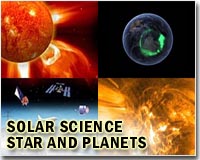 |
Greenbelt MD (SPX) Feb 22, 2011 Close to the globe, Earth's magnetic field wraps around the planet like a gigantic spherical web, curving in to touch Earth at the poles. But this isn't true as you get further from the planet. As you move to the high altitudes where satellites fly, nothing about that field is so simple. Instead, the large region enclosed by Earth's magnetic field, known as the magnetosphere, looks like a long, sideways jellyfish with its round bulb facing the Sun and a long tail extending away from the Sun. In the center of that magnetic tail lies the plasma sheet. Here, strange things can happen. Magnetic field lines pull apart and come back together, creating explosions when they release energy. Disconnected bits of the tail called "plasmoids" get ejected into space at two million miles per hour. And legions of charged particles flow back toward Earth. Such space weather events cause auroras and, when very strong, can produce radiation events that could cause our satellites to fail. But until now no one has been able to take pictures of these fascinating processes in the plasma sheet. Space weather events can also have profound effects on Earth's climate and, ultimately, the biosphere. Studying the connections between space weather and the habitability of Earth can help astrobiologists understand the role of such events in life's future on our planet. "Earth's magnetic tail and its charged particles are invisible to conventional cameras that detect light," says Jim Slavin, a magnetotail researcher who is the Director of the Heliophysics Division at NASA's Goddard Space Flight Center in Greenbelt, Md. "Events going on there have only been inferred based on other kinds of measurements." Now, special cameras aboard the Interstellar Boundary Explorer, or IBEX, spacecraft have snapped the first shots of this complex space environment. Instead of recording light, these two large single-pixel cameras detect energetic neutral atoms. Such fast-moving atoms are formed whenever atoms in the furthest reaches of Earth's atmosphere collide with charged particles and get sent speeding off in a new direction. Called Energetic Neutral Atom or ENA imaging, the technique captured unprecedented images of the plasma sheet. "The image alone is remarkable and would have made a great paper in and of itself because it's the first time we've imaged these important regions of the magnetosphere," says Dr. David McComas, principal investigator of the IBEX mission and assistant vice president of the Space Science and Engineering Division at Southwest Research Institute in San Antonio, Texas. The results appeared online in the Journal of Geophysical Research on Feb. 16, 2011. But when they looked closely, the group realized they didn't only have a picture of a quiescent plasma sheet. The various images appear to show a piece of the plasma sheet being bitten off and ejected down the tail. They think they've caught a plasmoid in the moment it was being formed. If they're correct, this would be the first time such an event was directly seen. "Imagine the magnetosphere as one of those balloons that people make animals out of. If you take your hands and squeeze the balloon, the pressure forces the air into another segment of the balloon," says McComas. "Similarly, the solar wind at times increases the pressure around the magnetosphere, resulting in a portion of the plasma sheet being pinched away from a larger mass and forced down the magnetotail." Because researchers believe this phenomenon generally occurs deeper in the magnetotail, the IBEX team is considering other explanations for the event, as well. One possibility is that the plasma sheet is being squeezed by the solar wind. While not specifically designed to observe the magnetosphere, IBEX's vantage point in space provides twice-yearly (spring and fall) seasons for viewing from outside the magnetosphere. Since its October 2008 launch, the IBEX science mission has flourished into multiple other research studies as well. In addition to supporting magnetospheric science, the spacecraft has also directly collected hydrogen and oxygen from the interstellar medium for the first time and produced the first ENA images of the outer edges of the bubble surrounding the Sun, called the heliosphere. "Based upon the IBEX mission and its revolutionary ENA camera technology," says Slavin, "future NASA science missions may be able to make high definition videos of the development of space weather systems around the Earth to advance our scientific understanding of these phenomena and, eventually, enable space weather prediction like Earth weather prediction."
Share This Article With Planet Earth
Related Links IBEX at NASA Solar Science News at SpaceDaily
 Space weather could wreak havoc in gadget-driven world
Space weather could wreak havoc in gadget-driven worldWashington (AFP) Feb 20, 2011 A geomagnetic space storm sparked by a solar eruption like the one that flared toward Earth Tuesday is bound to strike again and could wreak havoc across the gadget-happy modern world, experts say. Contemporary society is increasingly vulnerable to space weather because of our dependence on satellite systems for synchronizing computers, airline navigation, telecommunications networks and oth ... read more |
|
| The content herein, unless otherwise known to be public domain, are Copyright 1995-2010 - SpaceDaily. AFP and UPI Wire Stories are copyright Agence France-Presse and United Press International. ESA Portal Reports are copyright European Space Agency. All NASA sourced material is public domain. Additional copyrights may apply in whole or part to other bona fide parties. Advertising does not imply endorsement,agreement or approval of any opinions, statements or information provided by SpaceDaily on any Web page published or hosted by SpaceDaily. Privacy Statement |